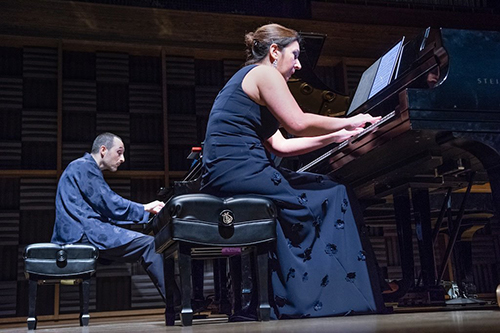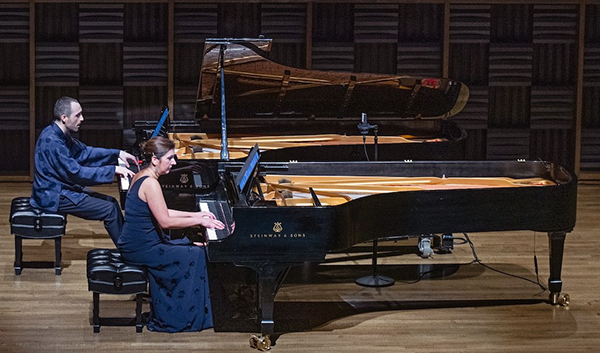by David Kulma

So it’s always a joy to hear two wonderful pianists team up in concert, as was the case on Sunday, March 24 when the local husband-and-wife duo of Antonio Pompa-Baldi and Emanuela Friscioni played the latest installment of the Tri-C Classical Piano Series at the Cleveland Museum of Art’s Gartner Auditorium.
Pompa-Baldi and Friscioni (who is director of the series) succeeded at making two pianos sound like one. Playing side by side, they could see each other’s hands and make easy eye contact. Not only were they perfectly in sync, their playing sounded effortless, agreeing completely on tempos and style.
20th-century Argentine composer Carlos Guastavino hewed close to traditional tonal ideas with a clear style that is both Latin and grounded in his nation’s music. A perfect example is his Tres romances argentinos, Op. 2 (1948). These three waltz-like pieces were ravishing in the hands of the performers. At times reminiscent of Liszt and Debussy, this pleasant triptych mixes pensive minor and vigorous major keys with a delightful melodic joie de vivre.

After intermission, the duo turned to two late 19th-century Russian pieces, both titled Suite No. 1 for Two Pianos. Anton Arensky’s Op. 15 and Sergei Rachmaninoff’s Op. 5 were each drenched in late Romantic virtuosity and attractive melodies. Arensky brought Chopin to mind, while Rachmaninoff’s four French-titled movements were dreamy and evocative of the river, night, sadness, and Easter church bells. Pompa-Baldi and Friscioni played them with emotive assurance and joy.
Two tango encores by Astor Piazzolla — Libertango and Oblivion — in vigorous and exciting arrangements by Italian pianist-composer Roberto Piana, sent the audience off into the early spring afternoon in a dancing mood.
Published on ClevelandClassical.com March 26, 2019.
Click here for a printable copy of this article



